Bingfeng Zhang
Unbiased Semantic Decoding with Vision Foundation Models for Few-shot Segmentation
Nov 19, 2025Abstract:Few-shot segmentation has garnered significant attention. Many recent approaches attempt to introduce the Segment Anything Model (SAM) to handle this task. With the strong generalization ability and rich object-specific extraction ability of the SAM model, such a solution shows great potential in few-shot segmentation. However, the decoding process of SAM highly relies on accurate and explicit prompts, making previous approaches mainly focus on extracting prompts from the support set, which is insufficient to activate the generalization ability of SAM, and this design is easy to result in a biased decoding process when adapting to the unknown classes. In this work, we propose an Unbiased Semantic Decoding (USD) strategy integrated with SAM, which extracts target information from both the support and query set simultaneously to perform consistent predictions guided by the semantics of the Contrastive Language-Image Pre-training (CLIP) model. Specifically, to enhance the unbiased semantic discrimination of SAM, we design two feature enhancement strategies that leverage the semantic alignment capability of CLIP to enrich the original SAM features, mainly including a global supplement at the image level to provide a generalize category indicate with support image and a local guidance at the pixel level to provide a useful target location with query image. Besides, to generate target-focused prompt embeddings, a learnable visual-text target prompt generator is proposed by interacting target text embeddings and clip visual features. Without requiring re-training of the vision foundation models, the features with semantic discrimination draw attention to the target region through the guidance of prompt with rich target information.
HCC-3D: Hierarchical Compensatory Compression for 98% 3D Token Reduction in Vision-Language Models
Nov 13, 2025Abstract:3D understanding has drawn significant attention recently, leveraging Vision-Language Models (VLMs) to enable multi-modal reasoning between point cloud and text data. Current 3D-VLMs directly embed the 3D point clouds into 3D tokens, following large 2D-VLMs with powerful reasoning capabilities. However, this framework has a great computational cost limiting its application, where we identify that the bottleneck lies in processing all 3D tokens in the Large Language Model (LLM) part. This raises the question: how can we reduce the computational overhead introduced by 3D tokens while preserving the integrity of their essential information? To address this question, we introduce Hierarchical Compensatory Compression (HCC-3D) to efficiently compress 3D tokens while maintaining critical detail retention. Specifically, we first propose a global structure compression (GSC), in which we design global queries to compress all 3D tokens into a few key tokens while keeping overall structural information. Then, to compensate for the information loss in GSC, we further propose an adaptive detail mining (ADM) module that selectively recompresses salient but under-attended features through complementary scoring. Extensive experiments demonstrate that HCC-3D not only achieves extreme compression ratios (approximately 98%) compared to previous 3D-VLMs, but also achieves new state-of-the-art performance, showing the great improvements on both efficiency and performance.
Fine-Grained Customized Fashion Design with Image-into-Prompt benchmark and dataset from LMM
Sep 11, 2025Abstract:Generative AI evolves the execution of complex workflows in industry, where the large multimodal model empowers fashion design in the garment industry. Current generation AI models magically transform brainstorming into fancy designs easily, but the fine-grained customization still suffers from text uncertainty without professional background knowledge from end-users. Thus, we propose the Better Understanding Generation (BUG) workflow with LMM to automatically create and fine-grain customize the cloth designs from chat with image-into-prompt. Our framework unleashes users' creative potential beyond words and also lowers the barriers of clothing design/editing without further human involvement. To prove the effectiveness of our model, we propose a new FashionEdit dataset that simulates the real-world clothing design workflow, evaluated from generation similarity, user satisfaction, and quality. The code and dataset: https://github.com/detectiveli/FashionEdit.
A Training-free Synthetic Data Selection Method for Semantic Segmentation
Jan 25, 2025



Abstract:Training semantic segmenter with synthetic data has been attracting great attention due to its easy accessibility and huge quantities. Most previous methods focused on producing large-scale synthetic image-annotation samples and then training the segmenter with all of them. However, such a solution remains a main challenge in that the poor-quality samples are unavoidable, and using them to train the model will damage the training process. In this paper, we propose a training-free Synthetic Data Selection (SDS) strategy with CLIP to select high-quality samples for building a reliable synthetic dataset. Specifically, given massive synthetic image-annotation pairs, we first design a Perturbation-based CLIP Similarity (PCS) to measure the reliability of synthetic image, thus removing samples with low-quality images. Then we propose a class-balance Annotation Similarity Filter (ASF) by comparing the synthetic annotation with the response of CLIP to remove the samples related to low-quality annotations. The experimental results show that using our method significantly reduces the data size by half, while the trained segmenter achieves higher performance. The code is released at https://github.com/tanghao2000/SDS.
Frozen CLIP: A Strong Backbone for Weakly Supervised Semantic Segmentation
Jun 17, 2024Abstract:Weakly supervised semantic segmentation has witnessed great achievements with image-level labels. Several recent approaches use the CLIP model to generate pseudo labels for training an individual segmentation model, while there is no attempt to apply the CLIP model as the backbone to directly segment objects with image-level labels. In this paper, we propose WeCLIP, a CLIP-based single-stage pipeline, for weakly supervised semantic segmentation. Specifically, the frozen CLIP model is applied as the backbone for semantic feature extraction, and a new decoder is designed to interpret extracted semantic features for final prediction. Meanwhile, we utilize the above frozen backbone to generate pseudo labels for training the decoder. Such labels cannot be optimized during training. We then propose a refinement module (RFM) to rectify them dynamically. Our architecture enforces the proposed decoder and RFM to benefit from each other to boost the final performance. Extensive experiments show that our approach significantly outperforms other approaches with less training cost. Additionally, our WeCLIP also obtains promising results for fully supervised settings. The code is available at https://github.com/zbf1991/WeCLIP.
* CVPR 2024 Highlight
Rethinking Prior Information Generation with CLIP for Few-Shot Segmentation
May 14, 2024Abstract:Few-shot segmentation remains challenging due to the limitations of its labeling information for unseen classes. Most previous approaches rely on extracting high-level feature maps from the frozen visual encoder to compute the pixel-wise similarity as a key prior guidance for the decoder. However, such a prior representation suffers from coarse granularity and poor generalization to new classes since these high-level feature maps have obvious category bias. In this work, we propose to replace the visual prior representation with the visual-text alignment capacity to capture more reliable guidance and enhance the model generalization. Specifically, we design two kinds of training-free prior information generation strategy that attempts to utilize the semantic alignment capability of the Contrastive Language-Image Pre-training model (CLIP) to locate the target class. Besides, to acquire more accurate prior guidance, we build a high-order relationship of attention maps and utilize it to refine the initial prior information. Experiments on both the PASCAL-5{i} and COCO-20{i} datasets show that our method obtains a clearly substantial improvement and reaches the new state-of-the-art performance.
Adaptive Bidirectional Displacement for Semi-Supervised Medical Image Segmentation
May 01, 2024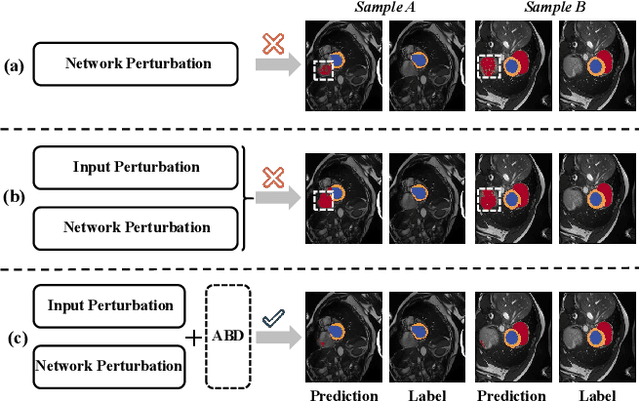
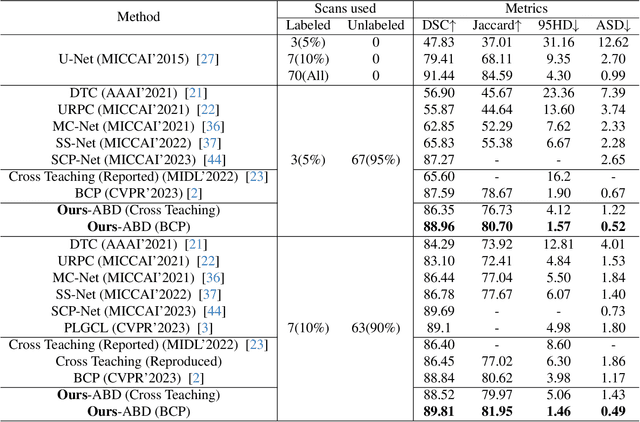
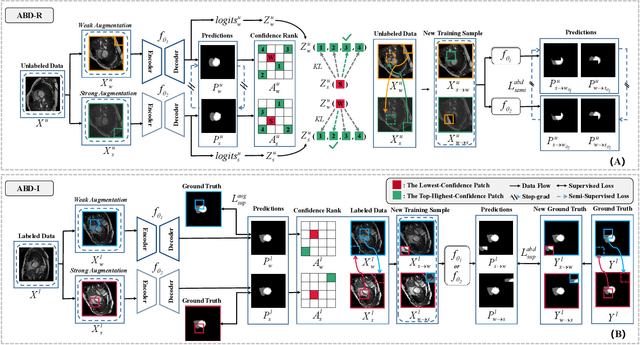
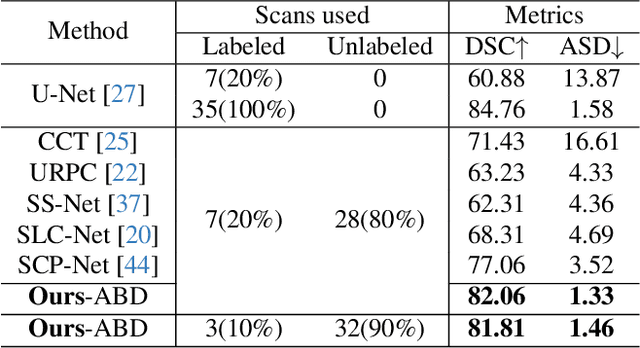
Abstract:Consistency learning is a central strategy to tackle unlabeled data in semi-supervised medical image segmentation (SSMIS), which enforces the model to produce consistent predictions under the perturbation. However, most current approaches solely focus on utilizing a specific single perturbation, which can only cope with limited cases, while employing multiple perturbations simultaneously is hard to guarantee the quality of consistency learning. In this paper, we propose an Adaptive Bidirectional Displacement (ABD) approach to solve the above challenge. Specifically, we first design a bidirectional patch displacement based on reliable prediction confidence for unlabeled data to generate new samples, which can effectively suppress uncontrollable regions and still retain the influence of input perturbations. Meanwhile, to enforce the model to learn the potentially uncontrollable content, a bidirectional displacement operation with inverse confidence is proposed for the labeled images, which generates samples with more unreliable information to facilitate model learning. Extensive experiments show that ABD achieves new state-of-the-art performances for SSMIS, significantly improving different baselines. Source code is available at https://github.com/chy-upc/ABD.
Democracy Does Matter: Comprehensive Feature Mining for Co-Salient Object Detection
Mar 11, 2022



Abstract:Co-salient object detection, with the target of detecting co-existed salient objects among a group of images, is gaining popularity. Recent works use the attention mechanism or extra information to aggregate common co-salient features, leading to incomplete even incorrect responses for target objects. In this paper, we aim to mine comprehensive co-salient features with democracy and reduce background interference without introducing any extra information. To achieve this, we design a democratic prototype generation module to generate democratic response maps, covering sufficient co-salient regions and thereby involving more shared attributes of co-salient objects. Then a comprehensive prototype based on the response maps can be generated as a guide for final prediction. To suppress the noisy background information in the prototype, we propose a self-contrastive learning module, where both positive and negative pairs are formed without relying on additional classification information. Besides, we also design a democratic feature enhancement module to further strengthen the co-salient features by readjusting attention values. Extensive experiments show that our model obtains better performance than previous state-of-the-art methods, especially on challenging real-world cases (e.g., for CoCA, we obtain a gain of 2.0% for MAE, 5.4% for maximum F-measure, 2.3% for maximum E-measure, and 3.7% for S-measure) under the same settings. Code will be released soon.
Dynamic Feature Regularized Loss for Weakly Supervised Semantic Segmentation
Aug 03, 2021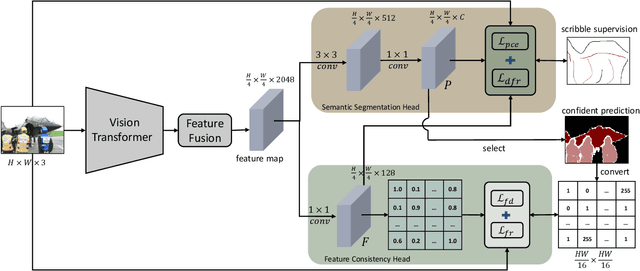
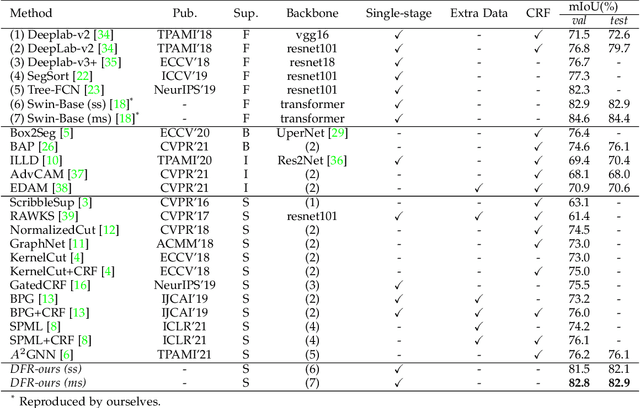
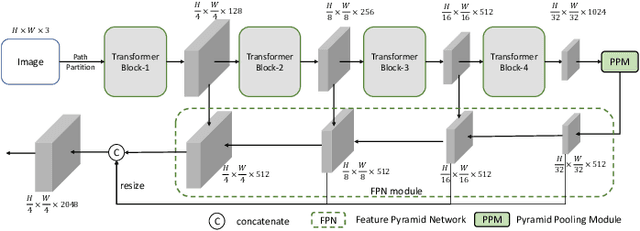

Abstract:We focus on tackling weakly supervised semantic segmentation with scribble-level annotation. The regularized loss has been proven to be an effective solution for this task. However, most existing regularized losses only leverage static shallow features (color, spatial information) to compute the regularized kernel, which limits its final performance since such static shallow features fail to describe pair-wise pixel relationship in complicated cases. In this paper, we propose a new regularized loss which utilizes both shallow and deep features that are dynamically updated in order to aggregate sufficient information to represent the relationship of different pixels. Moreover, in order to provide accurate deep features, we adopt vision transformer as the backbone and design a feature consistency head to train the pair-wise feature relationship. Unlike most approaches that adopt multi-stage training strategy with many bells and whistles, our approach can be directly trained in an end-to-end manner, in which the feature consistency head and our regularized loss can benefit from each other. Extensive experiments show that our approach achieves new state-of-the-art performances, outperforming other approaches by a significant margin with more than 6\% mIoU increase.
Affinity Attention Graph Neural Network for Weakly Supervised Semantic Segmentation
Jun 08, 2021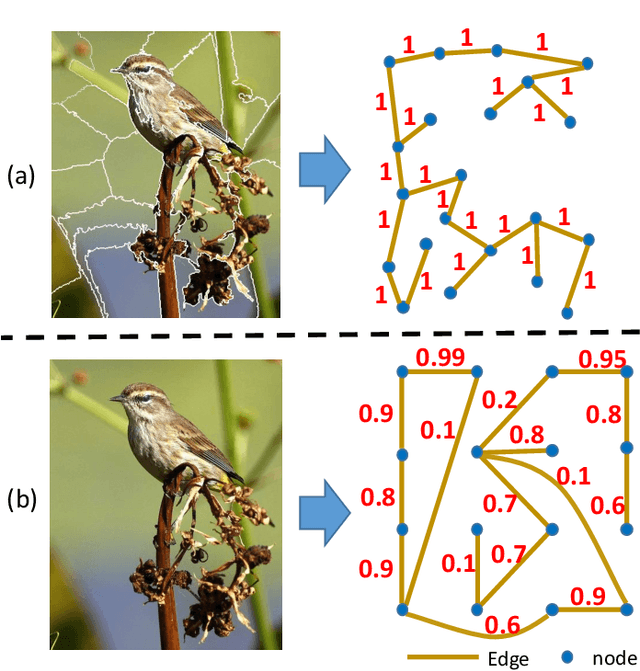
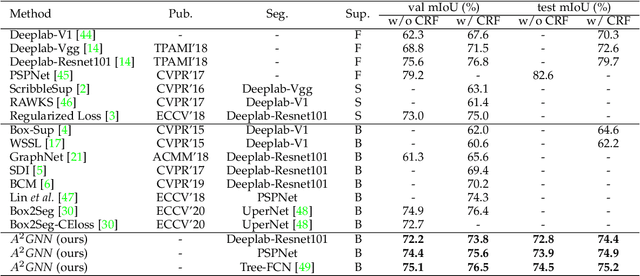
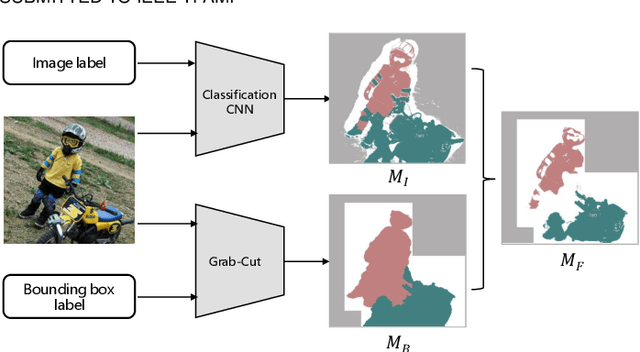

Abstract:Weakly supervised semantic segmentation is receiving great attention due to its low human annotation cost. In this paper, we aim to tackle bounding box supervised semantic segmentation, i.e., training accurate semantic segmentation models using bounding box annotations as supervision. To this end, we propose Affinity Attention Graph Neural Network ($A^2$GNN). Following previous practices, we first generate pseudo semantic-aware seeds, which are then formed into semantic graphs based on our newly proposed affinity Convolutional Neural Network (CNN). Then the built graphs are input to our $A^2$GNN, in which an affinity attention layer is designed to acquire the short- and long- distance information from soft graph edges to accurately propagate semantic labels from the confident seeds to the unlabeled pixels. However, to guarantee the precision of the seeds, we only adopt a limited number of confident pixel seed labels for $A^2$GNN, which may lead to insufficient supervision for training. To alleviate this issue, we further introduce a new loss function and a consistency-checking mechanism to leverage the bounding box constraint, so that more reliable guidance can be included for the model optimization. Experiments show that our approach achieves new state-of-the-art performances on Pascal VOC 2012 datasets (val: 76.5\%, test: 75.2\%). More importantly, our approach can be readily applied to bounding box supervised instance segmentation task or other weakly supervised semantic segmentation tasks, with state-of-the-art or comparable performance among almot all weakly supervised tasks on PASCAL VOC or COCO dataset. Our source code will be available at https://github.com/zbf1991/A2GNN.
 Add to Chrome
Add to Chrome Add to Firefox
Add to Firefox Add to Edge
Add to Edge